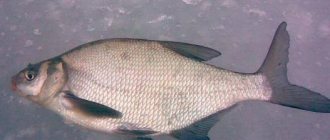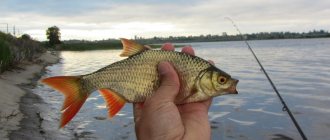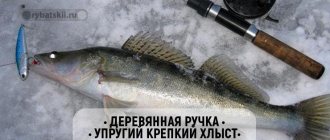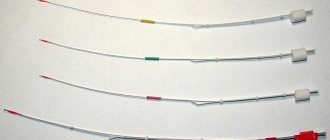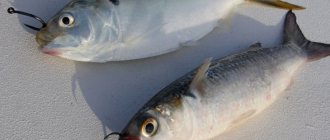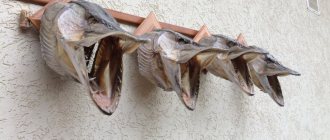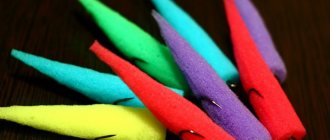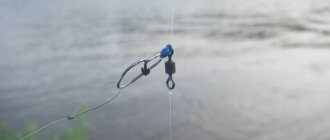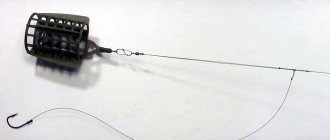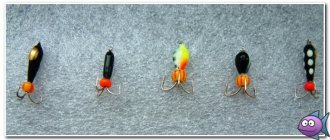A zherlitsa is a bait fishing tackle used for catching predatory fish. This fishing device is a fishing rod (sometimes an ordinary rod plays its role), fixed in the ground, at the bottom of a reservoir or in ice (for winter fishing, poles on a stand are used), with a fishing line tied to it, wound on a reel or other line-spreading device.
A leash with a hook, in turn, is attached to the fishing line; as a rule, it is a double or tee, onto which live bait is attached. When catching predatory fish, quite often a so-called cut occurs, when the predator simply bites the line while fishing. To avoid having to frequently change all the equipment, replaceable leashes are used, made from a material stronger than the main fishing line.
What leashes to choose for pike rigs?
Threads made of various metals (steel, tungsten, titanium, etc.) are used as driving material. However, metal leashes are quite noticeable and the operation of a girder with such equipment occurs, as a rule, in the dark, when, due to the paucity of lighting, the pike does not notice the shortcomings of the metal equipment.
Even during winter ice fishing, the main operation of girders with metal equipment occurs at dawn or late in the evening.
The main requirements for the material for the section between the fishing line and the hook are strength and invisibility. Of course, in terms of strength, it is difficult for any material to compare with metals, but pike is an attentive and finicky fish, especially in winter, when the water is exceptionally clear, and the leash should be as inconspicuous as possible.
For these purposes, leashes made from fishing line are used, ranging from conventional ones made of polyamide materials (nylon, nylon) and polyethylene, to Kevlar threads and fluorocarbon.
There were opinions that fluorocarbon is less durable than nylon of the same diameter, but modern high-quality fluorocarbon fishing lines are not inferior in strength to their counterparts.
On a wide base.
This is the most common and successful type of girders for pike.
There is a special slot on the base through which we pass the fishing line; there are fasteners on it where the flag and stand are inserted. Thanks to the fastenings, the vent can be easily disassembled, which makes it convenient for transportation. There is a small plastic inertial reel located on the stand; it should have a good and smooth move.
Many anglers have problems attaching hooks for transportation. This problem can be easily solved; simply drill holes in the reels and attach hooks to them.
In order to charge our reel, we hold the fishing line and stop the reel with a flag. When biting, the pike spins the reel, and the flag is released from the pinching, informing us about the bite.
Expert opinion
Makarov Igor Tarasovich
Hunter and fisherman with 20 years of experience. Wildlife lover
Unfortunately, some girders made from low-quality plastic become too fragile in severe frost, so you need to buy only proven ones, since for successful fishing we need more than one or two girders.
The type of girders shown in the figure is also available for sale, but they have a number of significant disadvantages:
- The fishing line is attached to a regular reel and when it bites, when the fish starts to reel it in, it can get tangled.
- The flag is located low and is less visible. Especially if there is a lot of snow on the ice.
This is interesting: Taiga forests, taiga plants
The best harness leashes and their advantages
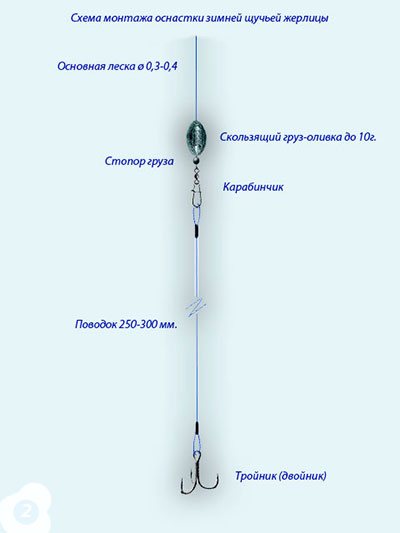
The most durable leashes for girders are still those made from metal leash material. Their main disadvantage is their visibility to fish, which is often not compensated for by their strength.
The combination of strength and flexibility is contained in leashes made of tungsten alloys; in addition, they have a fairly high breaking load. But this material is highly susceptible to deformation and after the first bite, the thread from it is curled into a spiral. Of course, the product can be straightened by heating it with a lighter, but then its strength will decrease. In addition, due to the fairly high price, tungsten laces cannot be considered a consumable material.
Braided steel leashes consisting of several threads are also widely used. They are quite soft, although compared to other materials they remain somewhat harsh; they are easy to find in specialized stores. But the drawback is the same - too noticeable.
Fluorocarbon

Fluorocarbon leashes have a number of advantages over analogues made from other materials:
- No deformation, unlike leads made of metals, especially tungsten;
- Invisibility for fish due to the fact that the light refractive index of this material is almost the same as that of water - the coefficient of fluorocarbon is 1.42, that of water is 1.3. This is the greatest advantage of fluorocarbon as a material for fishing line; for comparison, the refractive index of light in nylon is 1.52;
- Abrasion resistance. This indicator brings fluorocarbon slightly closer to the strength of metal products. In any case, this material copes better with pike teeth compared to conventional monofilament threads;
- Lightness and elasticity, which allows you to counteract line overlaps. Despite its lightness, fluorocarbon sinks 2 times better than nylon, which allows gear made from such material to always be under water;
- Resistance to a variety of aggressive environmental influences - temperature fluctuations and extremes, ultraviolet radiation, getting wet.
Top 3 brands

- Kureha Chemical Industries Co., Ltd, which at one time patented the technology for manufacturing fluorocarbon and now occupies a leading position, producing products under the trademarks “Riverge” and “Seaguar”;
- The SUNLINE concern (Japan) produces fairly high-quality products under the brand name KAIZEN;
- The American brand Scientific Anglers is popular among fly fishing enthusiasts; products under this brand are excellent for equipping fishing rods.
Where to catch pike
Features of pike behavior
In early December , as soon as there is ice, the pike begins to eat. Now the periods of greatest activity are morning dawn and evening sunset. But you have a chance of catching her throughout the day, and even at night. Promising places for installing girder equipment for pike are bays, backwaters above capes, small lakes, the mouths of medium-sized rivers and streams, as well as small harbors. It is necessary to search for pike in areas with a depth of 0.6-0.8 m to 2-3 m. Preference:
- Edge of aquatic vegetation (reeds, reeds),
- The bottom covered with snags, as well as areas near them;
- Various bottom anomalies (a section of shell rock against the background of a muddy bottom, tubercles, etc.)
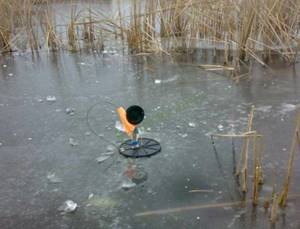
The cause of a weak bite or no bite can be sudden changes in weather.
In January-February, pike activity decreases significantly. But even during this period it can be caught, for which we need to install vents on the edge of wintering pits and channel edges; if the slope is gentle, then we are also interested in the slope itself. Here, the toothy fish hunts peaceful fish, and can gather in schools, which does not happen in the summer.
Areas where rivers or streams flow into a reservoir, bringing oxygen with them, are also considered promising.
With the onset of spring , when the thaw begins, pike activity increases. She returns to the shallow water again. You need to look for it at the edge of reeds and reeds, where it hunts for small fish.
Features of pike fishing in reservoirs
In small bodies of water, where the depth is no more than 3 m, you are unlikely to find a pike larger than 3 kg, but it is very hungry and will peck at your live bait with great zeal, since it has already caught almost all the rest of the small fish.
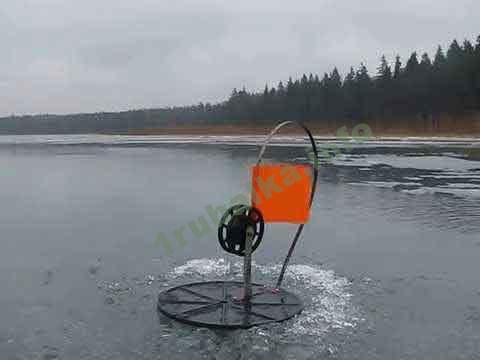
It is much more difficult to find it on large lakes, bays and reservoirs, but here you have the opportunity to get a solid trophy. Before going out into a body of water with a current, I advise you to read the article Fishing for pike on the river in winter .
Regular fishing line
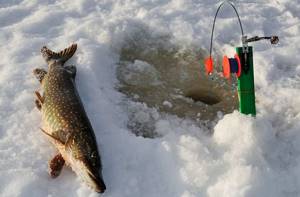
Regular fishing line is an affordable material, also quite suitable for making leashes and costs slightly less than fluorocarbon.
For use as a leader material, a high value of the following parameters is important:
- bite and tear strength, impact strength,
- elasticity and stretchability,
- wear resistance, abrasion resistance,
- visibility, or rather, invisibility for fish.
To compensate for the lack of strength, large cords are used from which a double pigtail leash is made.
Braided line is by no means a panacea for preventing line shearing. Despite the impressive breaking load, it is also easily bitten by a predator, which gradually breaks its fibers. Therefore, a braid no thinner than 0.35 mm is used. But during winter fishing, such a fishing line absorbs water and begins to freeze to the ice.
Monofilament fishing lines are inexpensive and at the same time hardly noticeable in the water. They provide sufficient mobility for live bait, but to use it on pike you need a diameter of 0.4 mm, and even this size is easily bitten or crushed by a predator.
Top 3 brands
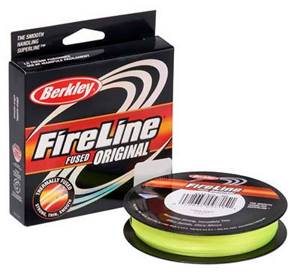
- "Fireline" from Berkley,
- "Power pro" from Shimano,
- "Herculine" from the American company Sufix.
Doubles
These hooks are used for long-term fishing. The shank of the hook is passed through the gills of the baitfish, and the stings protrude from its mouth. You can use crucian carp or perch as live bait.
Depending on which fish predominates in the pike’s habitat. The positive effect of this method of baiting is excellent camouflage.
When swallowing live bait, the predator does not feel the hook, so the chance of an unsuccessful bite or the bait breaking tends to zero.
This is interesting: Which bleeding should be stopped first?
Another advantage is that this method does not injure live bait and allows you to carefully remove the hook and reuse it on your next fishing trip.
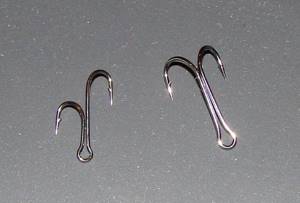
The disadvantage of doubles will be the long wait for a bite ; if the hooking is done ahead of time, most likely the predator will break and you will have to start all over again. Such fishing will definitely not fill you with vivid emotions, but for those who like a quiet, relaxing atmosphere, this will be an excellent choice.
Making leashes with your own hands at home

From fluorocarbon:
- first of all, you need to make a loop from fishing line, to do this, fluorocarbon is threaded into a crimp tube of the required length, a swivel is put on it, after which the fishing line is threaded into the tube again to make a loop,
- Next, you need to pull the fluorocarbon through the tube again in a different direction. As a result, two loops are formed on both sides of the crimp tube;
- the loop with the swivel must be tightened to a length of about 5-7 mm, the other loop is pulled in to the end of the tube, the excess ends of the fluorocarbon are cut off,
- Carefully crimp the tube, while maintaining the level of force applied. It is necessary to ensure that the loop does not crawl, but also that it is not pinched, otherwise there is a high probability of rupture at the crimp point. The tube should be crimped first along the edges, and then in the middle, perpendicular to the crimping along the edges. The ends of the tube are not flattened;
- Using the same rules, you need to make a loop with a hook.
The finished product should be 30-40 cm long.
Using the same algorithm, you can make equipment from any other fishing line.
Metal reins

Make it even easier. To do this, you can use material purchased in a specialized store or use material available at home, for example, guitar strings or cable wire:
- at the end of the wire you need to fold a loop and fix it with several turns around the axis,
- the same loop must be made at the other end of the wire, but the tip should be twisted in the opposite direction,
- the wire is twisted tightly using a drill and two hooks, one of which is inserted into the tool, and the other is screwed somewhere (for example, into a wall).
The result is a leash with an even twist and neat loops for hooking and attaching to the main fishing line.
Tips for choosing leashes for harnesses
Often, for a certain type of fishing, certain qualities of the fishing line become especially important. This also applies to the choice of material for the leash, because you have to make a choice between the visibility of the fishing line and its strength, or rather, look for a compromise.
For pike
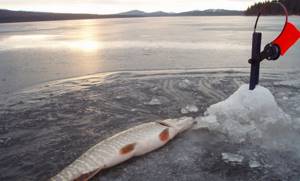
As noted above, there are a considerable number of different leashes for pike. This is due to both the sharpness of her teeth and her attentiveness. Until now, there is no material that would simultaneously satisfy all the requirements for strength and inconspicuousness, as well as the degree of rigidity. When choosing such material, it is worth considering that pike feeds in places with various shelters in the form of snags, stones, algae thickets, etc.
In this regard, the breaking load should still differ slightly from the same parameter of the main fishing line, so as not to lose the entire tackle if it breaks. In addition, you need to understand that non-metallic equipment cannot guarantee against biting, so you need to be prepared to lose a certain amount of equipment and not get upset again.
In any case, after each bite you should replace the leader material with fresh one so that microdamages do not weaken the tackle.
To another fish

It so happened that the girder is considered more of a pike tackle, if only because the bulk of the fish caught with its help are pike. But fishing in itself with the help of girders is quite convenient, so this type of fishing device can also be used on other fish caught with live bait.
From the second half of summer you can catch pike perch using live bait. At this time, he prefers foods high in protein. Its teeth are not as sharp as those of a pike, so an important property of the rein is its invisibility for prey. The thickness of the line for a leash for pike perch is up to 0.4 mm, length 30-45 cm. It is better to use thinner material, a diameter of 0.4 mm is advisable to use if pike is expected to bite.
For pike perch, the bait must be kept moving, which is ensured by a medium-hard thread with a diameter of 0.2-0.3 mm. And the length should be selected depending on the bait used, a length of up to 45 cm is suitable for active bleak or roach, and for quieter live bait, such as gudgeon or perch, you can use a longer fishing line.
It’s easiest to choose gear for burbot. For these purposes, any fishing line that is not very rigid (diameter 0.3-045 mm, length up to 30 cm) is suitable. A fishing line with a smaller diameter can be frayed by burbot, while a thicker one can spook the fish, despite the fact that the burbot is perceived as indiscriminate and insatiable.
With the help of a girder you can catch catfish. This inhabitant of the bottom of reservoirs requires more massive equipment and for the leader section a thread of 0.8-1.1 mm is used, and sometimes cords made of rawhide, leaders are also used from flexible leader material - titanium, nichrome, the main thing is to ensure a certain mobility of the live bait . Rein length – 50 cm.
Material for leashes
At the very beginning, citing as an example a leash for a pike made of ordinary steel wire, as a completely normal phenomenon for that time in our Hangar, I do not deny that now everything has changed dramatically. When purchasing sometimes expensive gear and bait, we definitely consider the aesthetic side of fishing, and also strive to minimize the impact of parts of the equipment on the fishing process.
This applies to leashes and the materials from which they are made. Having tried several models, we choose the one most suitable for our conditions and use it for a long time. But after some time, views and fishing style change. We are looking for new options again. But, unfortunately, with a large selection, it is difficult to find what turns out to be “the best.”
And now I’ll move directly to the types of leashes based on the material of manufacture and conditions of use.
Monofilament line
I used monofilament line as a leader material in isolated cases. I wanted to see what would happen. Unfortunately, it was not possible to catch a pike; the perch were biting.
Nothing special, except a noticeable change in the movement of the wobbler and its play. He no longer breaks away from his place, but follows in this manner with the stretching and contraction of his monk. Which has a positive effect in conditions where you need to persuade very intractable fish.
And here's what you need to know: Fishing for pike perch on the Kama
This is a braid made of numerous thin steel veins covered with a thin shell. Sold in unwinds and is a valuable material for making homemade leashes.
Leashes made from this material have a small diameter and are easy to knit both at home and in a combat situation on the shore of a reservoir. By the way, a fluorocarbon leader is made in the same way.
- We cut off the required piece from the bobbin, remembering that we need a piece ten centimeters larger than the required length of the future leash.
- We put two crimping tubes on a piece of leash material.
- At the ends of the segment we make a loop, after inserting swivels with carabiners or winding rings into them.
- We thread the ends of the veins into crimp tubes. If the tubes allow, then we thread the vein several times to ensure tight contact.
- We crimp each tube in two places, turning it 90 degrees.
The result is an excellent leash, and its price will be five times less than its store-bought counterpart.
Reviews from experienced fishermen
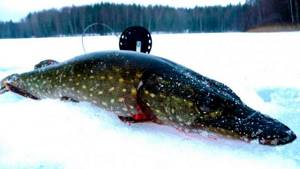
In my opinion, if we talk about pike, then the leash should only be metal. Well, she has a snack, she grinds other leashes. During winter fishing, the leash may rub against the lower edge of the ice when the pike's head is already visible. Imagine how embarrassing it will be! And visibility is not always so important, if only there were fish. Grade:
Basil
Normal fluorocarbon leashes often cope with the teeth of a predator, of course, if the diameter is not less than 0.4 mm. I speak from experience, I often observed burrs on the fishing line from teeth, perhaps not from a direct bite, but from friction against the teeth, but fluorocarbon still holds. When fishing, you need to make sure that the leash does not come out of the corner of the mouth, with each jerk you have time to give in the line, but not give any slack. Grade:
Vyacheslav
I tried both tungsten and steel string, yes, it doesn’t bite, but the bite is better when using fishing line and, accordingly, there is more interest. But fluorocarbon is generally not noticeable in the water, it bites often, and then it depends on your luck, and in fact it all depends on experience. Grade:
Egor
You just don’t need to get hung up on any one material. I use both metal and leashes made of fishing line, fluorocarbon, I put in more fishing rods and don’t leave without a catch, which is what I wish for you. Grade:
Taras
For spinning fishing
The most popular baits for spinning fishing are wobblers, spinners and silicone baits, for each of which appropriate hooks are selected.
- For oscillating and rotating spinners, single, double and triple hooks are used. Sometimes a hook with 4 or even more hooks is used.
- Wobblers are rarely equipped with double hooks; triple or single hooks are often used.
- Silicone baits are equipped with an offset, double or triple hook.
For fishing with silicone, it is better to purchase special offset hooks. They can be of various shapes.
Expert opinion
Makarov Igor Tarasovich
Hunter and fisherman with 20 years of experience. Wildlife lover
When choosing, you also need to focus on the size, shape of the bait and the expected weight of the trophy. If the bait is narrow-bodied and elongated, hooks with a straight shank are suitable.
However, the most popular models are those with a wide curve on the fore-end - this is the shape that allows you to reliably hook the fish, thereby reducing the number of empty bites.
